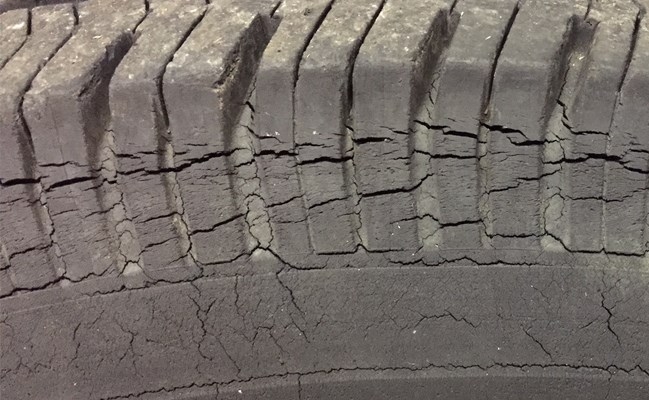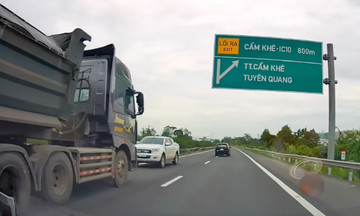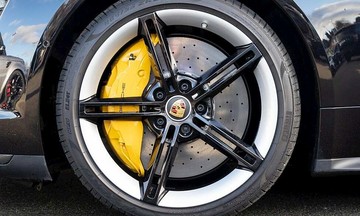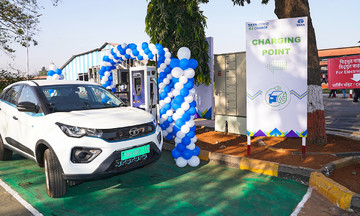At approximately 12:35 AM on 3/7 (Madrid time), 28-year-old Liverpool and Portugal national team forward Diogo Jota and his brother died in a traffic accident in the province of Zamora, Spain. The incident occurred at a bend on the A-52 highway. Initial investigations suggest a tire blowout caused the vehicle to lose control, flip multiple times, and catch fire.
 |
The scene of the accident on the A-52 highway, Cernadilla, Zamora, Spain. Video still. |
Tire blowouts at high speeds are not uncommon and can have devastating consequences. According to the US National Highway Traffic Safety Administration (NHTSA), tire failures contribute to approximately 11,000 accidents and 200 fatalities annually in the United States.
Thanh Mai (TP HCM) recounted a "terrifying" experience while driving on the Trung Luong - My Thuan highway during a recent rainy season. While traveling at 80 km/h in pouring rain, she heard an unusual noise from the right side, followed by the steering wheel becoming unstable and veering off course. She reacted by slowing down, gripping the steering wheel firmly, guiding the car to the emergency lane, activating hazard lights, exiting the vehicle to place additional warning signals behind it, and finally, returning to the car to call for assistance.
"My car is regularly serviced, yet I still experienced a tire blowout. This experience in the blinding rain was very frightening, but thankfully no serious accident occurred," Mai said.
Causes of tire blowouts:
Several factors can cause a tire blowout or rapid air loss on the highway, primarily relating to tire pressure and tread condition.
Over-inflation is a common cause. Excessive pressure forces air to escape, potentially rupturing the tire. Under-inflation can also lead to blowouts. When a tire is under-inflated, the sidewalls bear increased pressure from the vehicle's weight, leading to compression, deformation, and tears. This compression also increases the contact area with the road surface, generating more heat and increasing the risk of punctures from rocks or sharp objects. Exceeding the tire's load capacity also increases pressure and risk.
Tread-related causes include excessive wear without replacement, cracks due to rubber aging, and prolonged high-speed driving on worn tires.
Recognizing a tire blowout:
During a high-speed blowout, drivers may hear a loud bang or hissing sound from the wheel well. The steering wheel may suddenly pull to one side, vibrate intensely, or jerk, causing the vehicle to deviate from its intended path.
Steps to take:
 |
Thanh Mai's car with a flat tire on the highway. Photo: *Thanh Mai* |
When a blowout occurs, the vehicle will suddenly veer off course. Many drivers instinctively slam on the brakes, which can be dangerous, potentially causing further loss of control. The correct response is to remain calm, release the accelerator, firmly grip the steering wheel with both hands, and steer in the direction the vehicle is pulling. Focus your gaze ahead to identify a safe path, rather than panicking and looking at the front of the car. If the steering wheel pulls strongly, gently counter-steer to maintain a straight trajectory.
Once the vehicle's direction is stabilized, gradually apply the brakes to reduce speed, activate hazard lights, and carefully move to a safe area, such as the emergency lane or the right shoulder. Throughout this process, remain aware of surrounding traffic. Finally, call for roadside assistance or change the tire yourself if you have a spare and are able to do so safely. Always place warning signals when parked.
Preventing tire blowouts:
"Prevention is better than cure" is the best advice for avoiding tire-related accidents. Maintain the recommended tire pressure, which is usually printed on a sticker on the driver's side doorjamb. Tires typically last 7-10 years from their manufacturing date, so avoid using old tires even if the tread appears unworn.
 |
Cracked tire sidewall due to aging, also known as "dry rot". Photo: *Bridgestone LB* |
Most modern tires use rubber that is resistant to aging if used according to manufacturer guidelines. During routine maintenance at authorized service centers, technicians typically inspect, rotate, and advise on tire replacement. Drivers who don't use authorized services should be proactive about tire rotation, replacement schedules, and tread inspection.
If a tire has been patched multiple times, especially in close proximity, it's best to replace it. While there's no specific recommendation in Vietnam for the maximum number of patches, Bridgestone Australia's website advises a maximum of three repairs. Monitor the tire's condition after multiple patches, checking for tread wear and increased air loss. If these occur, replace the tire.
Consider installing tire pressure monitoring sensors (TPMS) for real-time monitoring while driving. This allows for early detection of unusual pressure drops or increases, helping to prevent accidents. Rotate tires every 10,000-20,000 km or every 6 months to ensure even wear and extend their lifespan. Avoid potholes and road debris whenever possible. Finally, minimize parking in direct sunlight, as UV rays accelerate tire aging.
Ho Tan











